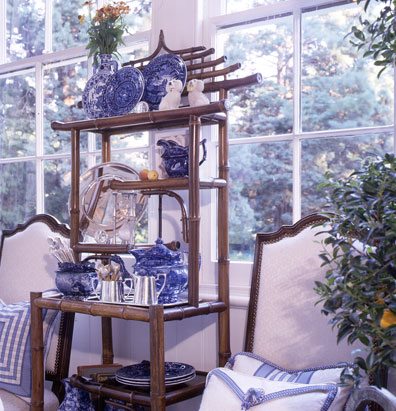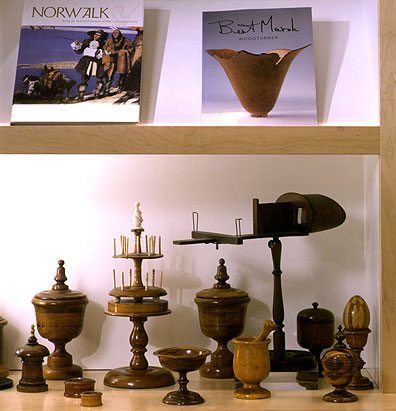Trudy Dujardin: The Beauty of Collections
February 21, 2012
Reading Jared Ainscough’s recent “Sneak Peek: Collector’s Table†inspired me to share some of my passion for collections, both in my own home and in the interiors I create for my clients. There’s nothing more eye-catching or more certain to start a conversation than displaying a beautiful collection. Whether you fall in love with tea caddies, Sandwich glass or Nantucket lightship baskets, collections are uniquely personal and clearly proclaim your interests. I have always been an ardent collector of antiques, and the addition of carefully selected pieces to sophisticated interiors is a recognizable signature of my design style.
The simple gesture of placing an antique tea caddy on a mantel can inspire my clients to begin collections of their own. There is tremendous beauty in items preserved throughout the years, particularly if they illuminate another time and way of life. Learning to appreciate the subtle differences between artisans and the time in which an item was created or the materials that were used give us a greater appreciation for life.
My personal collections include treenware, hotel silver, blue and white porcelain and things that speak to me of lives lived on the ocean, including whaling artifacts, scrimshaw carvings and sailor whirligigs. If you’re considering a collection of your own, here are five ideas that fit beautifully into any style of home:
Blue and White Chinese Export Porcelain
Blue and white porcelain began in China in the first half of the fourteenth century and continued through the eighteenth century, produced in response to demand from European markets. Porcelain manufacturing secrets were carefully guarded, yet the very first acts of industrial spying soon led to the knowledge being transferred to Europe. There new processes were created, such as transfer printing, allowing the precious porcelain to be widely available instead of restricted only to the very wealthy.

This nineteenth-century Chinese-influenced étagère shows a collection of blue and white porcelain, both Chinese exportware and Staffordshire English pottery. Hotel silver has been added for sparkle.
Hotel Silver
Hotel silver was made for the grand hotels, railways and steamship lines of Europe and America in the nineteenth century, and it reflects a more elegant, genteel style of living. Vintage pieces can be used to hold bouquets of fresh flowers, serve exquisite desserts, or simply for display. You can find pitchers, coffee urns, teapots, bowls and cutlery to add sparkle to your home and table.

Elegance in entertaining is assured with this nineteenth-century French balloon-handled fish service. The introduction of a seashell is a casual complement to the nineteenth-century blue and white Staffordshire plate.
Treenware
Treenware is a term applied to handcarved and handcrafted wooden implements used in the home in the eighteenth and nineteenth centuries (the word treen, from the Old English, means “woodenâ€). The pieces were often functional.

This is a fabulous collection of treenware dating from the nineteenth to the twentieth century. Note the darning egg and the antique stereoscope–the earliest form of television! The book displayed is by British treenware master Bert Marsh.
Scrimshaw
Created by whalers to pass the time on ships long ago, scrimshaw began in the mid-1700s as the art of engraving pictures and lettering on bones, teeth and tusks of whales and other marine mammals. Early scrimshaw was done with crude sailing needles, and the skill of the artist can vary widely.

This extremely rare white tortoiseshell is an early nineteenth-century British scrimshaw. The whalers’ handwork details ships, whales and equipment used in their lives at sea.
Sailors’Â Woolies
Another way of passing long hours at sea, sailors created pictures embroidered on backgrounds of cotton duck (carried on board to make sailors’ uniforms) or sailcloth, and they often depicted British royal sailing vessels. Known as sailors’ woolies, these images date from the 1850s to the 1890s, when life on board ship changed with the advent of steam-powered ships, eliminating long voyages.

This is a mint condition eighteenth-century British woolie, “The Star of Bengal,†unusual for the ship’s identification as part of the design and for its display of the British flag.
There are hundreds of beautiful pieces available at antique shops and shows around the world. If you do start a collection, remember that you have become a caretaker for an irreplaceable part of history. Happy hunting!
–Trudy Dujardin
Trudy Dujardin is nationally known for her passion for eco-elegance, as well as award-winning interiors that combine sophistication, color, and an intuitive understanding of her clients’ lifestyles. Her approach to gently green design reflects a deep respect for historic preservation, the surrounding landscape and abundant comfort. Based on her belief that a healthy home is the ultimate luxury, she is a LEED-accredited professional specializing in interior design and construction based on a thorough understanding of green building practices and principles.
Share
![NEH-Logo_Black[1] NEH-Logo_Black[1]](https://b2915716.smushcdn.com/2915716/wp-content/uploads/2022/08/NEH-Logo_Black1-300x162.jpg?lossy=1&strip=1&webp=1)







You must be logged in to post a comment.